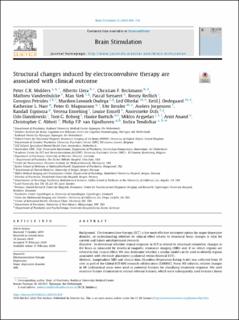Structural changes induced by electroconvulsive therapy are associated with clinical outcome
Mulders, Peter C. R.; Llera, Alberto; Beckmann, Christian F.; Vandenbulcke, Mathieu; Stek, Max L; Sienaert, Pascal; Redlich, Ronny; Petrides, Georgios; Oudega, Mardien L.; Oltedal, Leif; Ødegaard, Ketil Joachim; Narr, Katherine L; Magnusson, Peter; Kessler, Ute; Jorgensen, Anders; Espinoza, Randall; Enneking, Verena; Emsell, Louise; Dols, Annemieke; Dannlowski, Udo; Bolwig, Tom G; Bartsch, Hauke; Argyelan, Miklos; Anand, Amit; Abbott, Christopher; van Eijndhoven, Philip; Tendolkar, Indira
Journal article, Peer reviewed
Published version

Åpne
Permanent lenke
https://hdl.handle.net/11250/2761134Utgivelsesdato
2020Metadata
Vis full innførselSamlinger
- Department of Clinical Medicine [2043]
- Registrations from Cristin [9489]
Sammendrag
Background
Electroconvulsive therapy (ECT) is the most effective treatment option for major depressive disorder, so understanding whether its clinical effect relates to structural brain changes is vital for current and future antidepressant research.
Objective
To determine whether clinical response to ECT is related to structural volumetric changes in the brain as measured by structural magnetic resonance imaging (MRI) and, if so, which regions are related to this clinical effect. We also determine whether a similar model can be used to identify regions associated with electrode placement (unilateral versus bilateral ECT).
Methods
Longitudinal MRI and clinical data (Hamilton Depression Rating Scale) was collected from 10 sites as part of the Global ECT-MRI research collaboration (GEMRIC). From 192 subjects, relative changes in 80 (sub)cortical areas were used as potential features for classifying treatment response. We used recursive feature elimination to extract relevant features, which were subsequently used to train a linear classifier. As a validation, the same was done for electrode placement. We report accuracy as well as the structural coefficients of regions included in the discriminative spatial patterns obtained.
Results
A pattern of structural changes in cortical midline, striatal and lateral prefrontal areas discriminates responders from non-responders (75% accuracy, p < 0.001) while left-sided mediotemporal changes discriminate unilateral from bilateral electrode placement (81% accuracy, p < 0.001).
Conclusions
The identification of a multivariate discriminative pattern shows that structural change is relevant for clinical response to ECT, but this pattern does not include mediotemporal regions that have been the focus of electroconvulsive therapy research so far.
